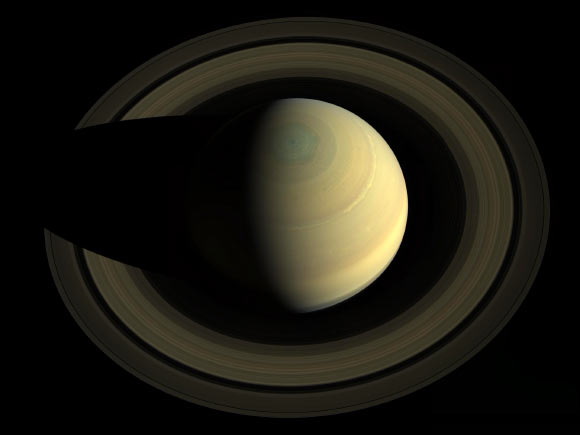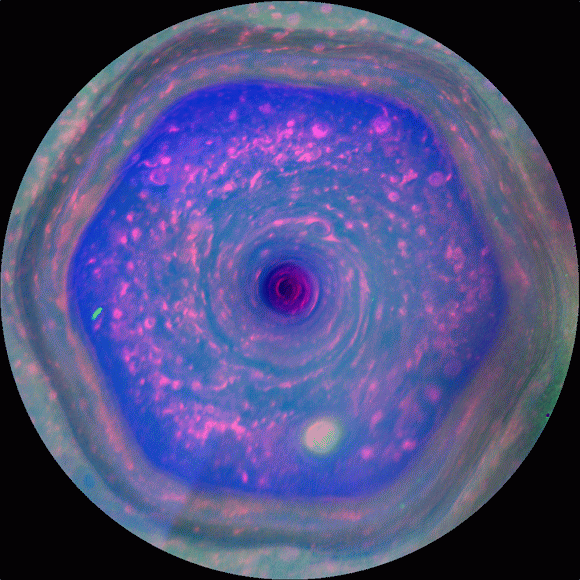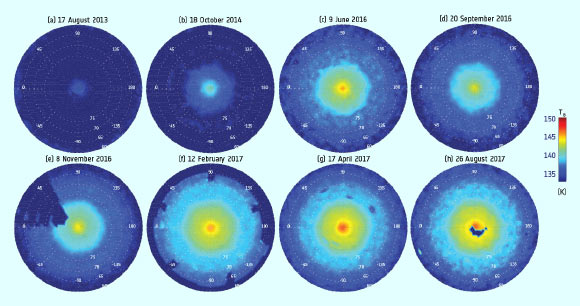When NASA’s Cassini spacecraft arrived at Saturn in 2004, the gas giant’s southern hemisphere was enjoying summertime, while the northern was in the midst of winter. Cassini spied a broad, warm, high-altitude vortex at Saturn’s southern pole, but none at the northern pole. A study led by the University of Leicester has now spotted the first glimpses of a northern polar vortex forming high in the atmosphere as Saturn’s northern hemisphere approached summertime. This warm vortex sits hundreds of miles above the clouds, in a layer of atmosphere known as the stratosphere.

A swing high above Saturn by NASA’s Cassini spacecraft revealed this view of the golden-hued planet and its main rings. The view is in natural color, as human eyes would have seen it. This mosaic was made from 36 images in three color filters obtained by Cassini’s imaging science subsystem on October 10, 2013. Saturn sports differently colored bands of weather in this image. For instance, a bright, narrow wave of clouds around 42 degrees north latitude appears to be some of the turbulent aftermath of a giant storm that reached its violent peak in early 2011. The mysterious six-sided weather pattern known as the hexagon is visible around Saturn’s north pole. Image credit: NASA / JPL-Caltech / SSI / Cornell University.
“The edges of this newly-found vortex appear to be hexagonal, precisely matching a famous and bizarre hexagonal cloud pattern we see deeper down in Saturn’s atmosphere,” said study led author Dr. Leigh Fletcher, a planetary researcher in the Department of Physics & Astronomy at the University of Leicester.
“While we did expect to see a vortex of some kind at Saturn’s north pole as it grew warmer, its shape is really surprising.”
Saturn’s cloud levels host the majority of the planet’s weather, including the pre-existing north polar hexagon.
This feature was discovered by NASA’s Voyager spacecraft in the 1980s and has been studied for decades; it is a long-lasting wave potentially tied to Saturn’s rotation, a type of phenomenon also seen on Earth in structures such as the Polar Jet Stream.
Its properties were revealed in detail by Cassini, which observed it in multiple wavelengths using several instruments, including its Composite Infrared Spectrometer (CIRS).
However, at the start of the mission CIRS could not peer further up in the northern stratosphere, which had temperatures around minus 158 degrees Celsius — some 20 degrees too cold for reliable CIRS infrared observations — leaving these higher-altitude regions relatively unexplored for many years.
“One Saturnian year spans roughly 30 Earth years, so the winters are long. Saturn only began to emerge from the depths of northern winter in 2009, and gradually warmed up as the northern hemisphere approached summertime,” said study co-author Dr. Sandrine Guerlet, a scientist with the Laboratoire de Météorologie Dynamique, France.

This view shows the famous hexagon, located in the clouds surrounding Saturn’s northern pole. Comprising data gathered by NASA’s Cassini mission, this animated visual, published in 2012, offered the first ever color view of Saturn’s hexagon, and was the first animated view to cover such a large section of this part of the planet (from the north pole down to a latitude of roughly 70 degrees north). The hexagon itself is an intriguing, swirling system of air currents and turbulent weather. Unlike Earth’s hurricanes, the hexagon has endured for decades at least, and shows no signs of abating. Image credit: NASA / JPL-Caltech / SSI / Hampton University.
A strange process at play within Saturn’s atmosphere sped up this warming: as air sank at the north pole, the upper hexagon warmed increasingly quickly, and the transport of air downwards made the abundance of several minor species more concentrated. The increased temperature allowed the team to study the polar vortex in infrared light.
“We were able to use the CIRS instrument to explore the northern stratosphere for the first time, from 2014 onwards. As the polar vortex became more and more visible, we noticed it had hexagonal edges, and realized that we were seeing the pre-existing hexagon at much higher altitudes than previously thought,” Dr. Guerlet said.
This indicates that Saturn’s two poles behave very differently — there was no hexagon at the south pole, either at the cloud tops or above, when it was observed early in Cassini’s mission during southern summer.
The northern vortex is also nowhere near as mature as the southern vortex, as it is cooler, and displays different dynamics from its southern counterpart.
“This could mean that there’s a fundamental asymmetry between Saturn’s poles that we’re yet to understand, or it could mean that the north polar vortex was still developing in our last observations and kept doing so after Cassini’s demise,” Dr. Fletcher said.
The presence of a hexagon way up in Saturn’s northern stratosphere, hundreds of miles above the clouds, suggests that there is much more to learn about the dynamics at play in the gas giant’s atmosphere.

These eight frames show Saturn’s northern pole as it appeared between the years of 2013 and 2017, as seen by Cassini’s Composite Infrared Spectrometer. From left to right, the panels date to 17 August 2013, 18 October 2014, 9 June 2016, 20 September 2016 (top row) and 8 November 2016, 12 February 2017, 17 April 2017, 26 August 2017 (bottom row). They map the changing temperatures in Saturn’s stratosphere and display these in colors ranging from cooler blues to hotter reds. Blue hues correspond to temperatures of minus 138 degrees Celsius and red hues to minus 123 degrees Celsius. The darkest blues show areas of missing data and defects; notably, a warm polar cyclone was partially obscured in the panel obtained in August 2017. The data were gathered by the CIRS instrument during Cassini’s solstice mission, the spacecraft’s second extension, which began in September 2010 and ended in May 2017. In order to properly view the planet’s north pole in full, Cassini observed from a high orbital inclination. The hexagonal shape and boundary of the stratospheric vortex can be seen in all panels, growing increasingly clearer and warmer as time goes on. Image credit: NASA / JPL-Caltech / University of Leicester / NASA’s Goddard Space Flight Center / Fletcher et al.
A single, towering hexagonal structure that stretches up through the atmosphere would be unlikely given that wind conditions change considerably with altitude.
However, by investigating the atmospheric properties in the northern region, the researchers also determined that waves like the hexagon should be unable to propagate upwards — they should remain trapped in the cloud-tops, as previously thought.
“One way that wave information can leak upwards is via a process called evanescence, where the strength of a wave decays with height but is just about strong enough to still persist up into the stratosphere,” Dr. Fletcher said.
“We simply need to know more. It’s quite frustrating that we only discovered this stratospheric hexagon right at the end of Cassini’s lifespan.”
The findings were published in the September 3, 2018 issue of the journal Nature Communications.
_____
L.N. Fletcher et al. 2018. A hexagon in Saturn’s northern stratosphere surrounding the emerging summertime polar vortex. Nature Communications 9, article number: 3564; doi: 10.1038/s41467-018-06017-3







